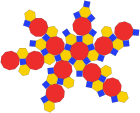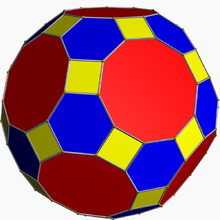Truncated icosidodecahedron
| Truncated icosidodecahedron | |
|---|---|
 (Click here for rotating model) | |
| Type | Archimedean solid Uniform polyhedron |
| Elements | F = 62, E = 180, V = 120 (χ = 2) |
| Faces by sides | 30{4}+20{6}+12{10} |
| Conway notation | bD or taD |
| Schläfli symbols | tr{5,3} or |
| t0,1,2{5,3} | |
| Wythoff symbol | 2 3 5 | |
| Coxeter diagram | |
| Symmetry group | Ih, H3, [5,3], (*532), order 120 |
| Rotation group | I, [5,3]+, (532), order 60 |
| Dihedral angle | 6-10: 142.62° 4-10: 148.28° 4-6: 159.095° |
| References | U28, C31, W16 |
| Properties | Semiregular convex zonohedron |
 Colored faces |
 4.6.10 (Vertex figure) |
 Disdyakis triacontahedron (dual polyhedron) |
 Net |


The truncated icosidodecahedron is an Archimedean solid. It has 30 regular square faces, 20 regular hexagonal faces, 12 regular decagonal faces, 120 vertices and 180 edges. Since each of its faces has point symmetry (equivalently, 180° rotational symmetry), the truncated icosidodecahedron is a zonohedron.
Other names
Alternate interchangeable names include:
- Great rhombicosidodecahedron
- Rhombitruncated icosidodecahedron
- Omnitruncated icosidodecahedron
The name truncated icosidodecahedron, originally given by Johannes Kepler, is somewhat misleading. If you truncate an icosidodecahedron by cutting the corners off, you do not get this uniform figure: some of the faces will be rectangles. However, the resulting figure is topologically equivalent to this and can always be deformed until the faces are regular.
The alternative name great rhombicosidodecahedron (as well as rhombitruncated icosidodecahedron) refers to the fact that the 30 square faces lie in the same planes as the 30 faces of the rhombic triacontahedron which is dual to the icosidodecahedron. Compare to small rhombicosidodecahedron.
One unfortunate point of confusion is that there is a nonconvex uniform polyhedron of the same name. See uniform great rhombicosidodecahedron.
Cartesian coordinates
Cartesian coordinates for the vertices of a truncated icosidodecahedron centered at the origin are all the even permutations of
- (±1/τ, ±1/τ, ±(3+τ)),
- (±2/τ, ±τ, ±(1+2τ)),
- (±1/τ, ±τ2, ±(-1+3τ)),
- (±(-1+2τ), ±2, ±(2+τ)) and
- (±τ, ±3, ±2τ),
where τ = (1+√5)/2 is the golden ratio.
See also
- Spinning great rhombicosidodecahedron
- dodecahedron
- great truncated icosidodecahedron
- icosahedron
- icosidodecahedron
- truncated cuboctahedron
References
- Williams, Robert (1979). The Geometrical Foundation of Natural Structure: A Source Book of Design. Dover Publications, Inc. ISBN 0-486-23729-X. (Section 3-9)
External links
- The Uniform Polyhedra
- Virtual Reality Polyhedra The Encyclopedia of Polyhedra

